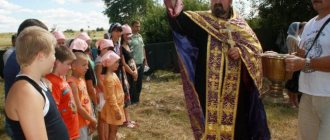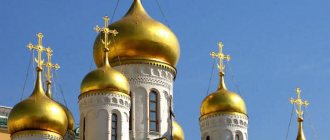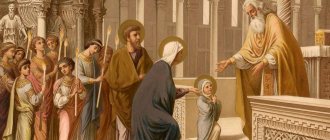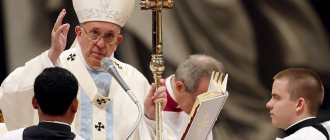Basics of Christianity
This religion is based on dogmas, which are interpreted in the Holy Scriptures and in Holy Tradition.
The first includes the book of the Bible, consisting of two parts (New and Old Testaments), and the Apocrypha, which are sacred texts that were not included in the Bible.
The second consists of seven ecumenical councils and the works of the church fathers who lived in the second to fourth centuries AD. These people include John Chrysostom, Athanasius of Alexandrovsky, Gregory the Theologian, Basil the Great, and John of Damascus.
Distinctive features of Orthodoxy
In all Orthodox countries, the main tenets of this branch of Christianity are observed. These include the following: the trinity of God (Father, Son and Holy Spirit), salvation from the Last Judgment through confession of faith, atonement for sins, incarnation, resurrection and ascension of God the Son - Jesus Christ.
All these rules and dogmas were approved in 325 and 382 at the first two Ecumenical Councils. The Orthodox Church proclaimed them eternal, indisputable and communicated to humanity by the Lord God himself.
Why were Catholics and Orthodox Christians divided?
In 1054, the Ecumenical Orthodox Church split into the Local Roman Church and a number of Eastern local Churches, united by common Orthodox dogmas. This happened due to different views on the interpretation of the doctrine of the Church and the doctrine of God. Also influenced by the desire of the Pope to become the generally recognized head of all Christian Churches. Theological differences also arose about the Filioque (the dogma of the Trinity). The Orthodox Church believes that the Holy Spirit comes from God the Father, the Catholic Church - from the Father and the Son. This became one of the reasons for the division.
It is worth noting that disagreements between Pope Leo IX and Patriarch Michael Cerularius of Constantinople arose long before the official date of the schism. But after the closure of the Latin churches in Constantinople, Pope Leo sent a message to Patriarch Michael, in which he outlined his desire to become the head of the entire Church. The result of the conflict was mutual anathemas at the level of individual church hierarchs. Although these anathemas did not apply to the Churches, they cemented the split between the two Christian denominations for many centuries until the present day.
Over the course of several more centuries, there were both attempts at rapprochement between the Churches and events that strengthened the schism. As a result, the Pope's insistence on recognizing his dogmas led to harsh measures from the Patriarchate of Constantinople. The entire Catholic Church was declared heretical.
Orthodox countries of the world
The religion Orthodoxy is professed by approximately 220 to 250 million people. This number of believers is a tenth of all Christians on the planet. Orthodoxy is spread throughout the world, but the highest percentages of people who profess this religion are in Greece, Moldova and Romania - 99.9%, 99.6% and 90.1% respectively. Other Orthodox countries have a slightly lower percentage of Christians, but Serbia, Bulgaria, Georgia and Montenegro also have high percentages.
The largest number of people whose religion is Orthodoxy live in the countries of Eastern Europe and the Middle East; there are a large number of religious diasporas throughout the world.
List of Orthodox countries
An Orthodox country is one in which Orthodoxy is recognized as the state religion.
The country with the largest number of Orthodox Christians is the Russian Federation. In percentage terms, it is, of course, inferior to Greece, Moldova and Romania, but the number of believers significantly exceeds these Orthodox countries.
- Greece – 99.9%.
- Moldova – 99.9%.
- Romania – 90.1%.
- Serbia – 87.6%.
- Bulgaria – 85.7%.
- Georgia – 78.1%.
- Montenegro – 75.6%.
- Belarus - 74.6%.
- Russia - 72.5%.
- Macedonia - 64.7%.
- Cyprus - 69.3%.
- Ukraine - 58.5%.
- Ethiopia - 51%.
- Albania - 45.2%.
- Estonia - 24.3%.
The distribution of Orthodoxy across countries, depending on the number of believers, is as follows: in first place is Russia with the number of believers 101,450,000 people, Ethiopia has 36,060,000 Orthodox believers, Ukraine - 34,850,000, Romania - 18,750,000, Greece - 10,030,000, Serbia - 6,730,000, Bulgaria - 6,220,000, Belarus - 5,900,000, Egypt - 3,860,000, and Georgia - 3,820,000 Orthodox.
Analysis December 19, 2011 A comprehensive demographic study of more than 200 countries found that there are 2.18 billion Christians of all ages worldwide, representing nearly a third of the world's estimated 6.9 billion population in 2010. At the same time, Christianity has such a wide geographical distribution that not a single continent or region can confidently be called the center of world Christianity.
More details https://www.pewforum.org/Christian/Global-Christianity-exec.aspx
Orthodox Christians
There are about 260 million Orthodox Christians in the world, which is 12% percent of the total number of Christians.
Almost four in ten Orthodox Christians (39%) live in Russia, the country with the largest number of Orthodox Christians. The second place is occupied by Ethiopia, where the number of Orthodox Christians is more than three times higher than the Orthodox population of Greece. Despite the fact that Turkey is the seat of the Ecumenical Patriarch of Constantinople, one of the most highly revered archbishops in the Orthodox world, the country's Orthodox population is relatively small (about 180,000).
| 10 countries with the largest number of Orthodox Christians | |||
| A country | Approximate size of the Orthodox population in 2010 | Share of Orthodox population in the country | Share of the total number of Orthodox Christians worldwide |
| Russia | 101 450 000 | 71% | 39% |
| Ethiopia | 36 060 000 | 43,5 | 13,9 |
| Ukraine | 34 850 000 | 76,7 | 13,4 |
| Romania | 18 750 000 | 87,3 | 7,2 |
| Greece | 10 030 000 | 88,3 | 3,9 |
| Serbia | 6 730 000 | 86,6 | 2,6 |
| Bulgaria | 6 220 000 | 83,0 | 2,4 |
| Belarus | 5 900 000 | 61,5 | 2,3 |
| Egypt | 3 860 000 | 4,8 | 1,5 |
| Georgia | 3 820 000 | 87,8 | 1,5 |
| Total number of Orthodox Christians in 10 countries | 227 660 000 | 54,9 | 87,4 |
| Number of Orthodox Christians in other countries | 23 720 000 | 0,2 | 12,6 |
| Total number of Orthodox Christians worldwide | 260 380 000 | 3,8 | 1000 |
| The approximate number is rounded to the nearest ten thousand. Percentages are calculated based on unrounded figures. Figures may be slightly inaccurate due to rounding. | |||
| Pew Research Center Forum on Religious and Social Life. World Christianity, December 2011. | |||
Nearly nine out of ten Orthodox Christians (87%) worldwide are in the 10 countries with the largest Orthodox populations. These countries generally have an Orthodox majority - although Orthodox Christians make up less than half of the total population in Ethiopia and only about 5% of the population in Egypt. Orthodox Christians make up the majority of the total population in 14 countries.
The Orthodox population is largely concentrated in Europe, which includes all of Russia. Europe is home to 77% of the world's Orthodox population, South Africa about 15% and the Asia-Pacific region (including Turkey) about 5%. A small percentage of Orthodox Christians also live in the Middle East and North Africa (about 2%) and in America (1%).
Orthodoxy in the Russian Federation
As noted above, the country of Russia is Orthodox, the number of believers is the largest in the world and extends over its entire large territory.
Orthodox Russia is famous for its multinationality; this country is home to a large number of peoples with different cultural and traditional heritage. But most of these people are united by their belief in the Holy Trinity: Father, Son and Holy Spirit.
Such Orthodox peoples of the Russian Federation include the Nenets, Yakuts, Chukchi, Chuvash, Ossetians, Udmurts, Mari, Nenets, Mordovians, Karelians, Koryaks, Vepsians, the peoples of the Komi Republic and Chuvashia.
Orthodoxy in North America
It is believed that Orthodoxy is a faith that is widespread in the Eastern part of Europe and a small part of Asia, but this religion is also present in North America, thanks to the huge diasporas of Russians, Ukrainians, Belarusians, Moldovans, Greeks and other peoples resettled from Orthodox countries .
Most North Americans are Christians, but they belong to the Catholic branch of this religion.
In Canada and the USA, attitudes towards religion are slightly different.
Many Canadians consider themselves Christians, but rarely attend church. Of course, there is a slight difference depending on the region of the country and urban or rural areas. It is known that city residents are less religious than country people. The religion of Canada is mainly Christian, the majority of believers are Catholics, followed by other Christians, and a significant portion are Mormons.
The concentration of the latter two religious movements is very different from region to region of the country. For example, many Lutherans live in the maritime provinces, once settled there by the British.
And in Manitoba and Saskatchewan there are many Ukrainians who profess Orthodoxy and are adherents of the Ukrainian Orthodox Church.
In the United States, Christians are less devout, but, compared to Europeans, they attend church more often and perform religious rituals.
Mormons are mainly concentrated in Alberta due to the migration of Americans who are representatives of this religious movement.
Europe Orthodox
Orthodoxy spread in Western Europe primarily as a result of mass emigration that occurred between the two world wars. We are talking, firstly, about 2.1 million people who emigrated from Russia after the revolution of 1917: many of them went to America, but many also settled in Europe (France, Germany, Great Britain). Secondly, after the death of Asia Minor Greece (1922-1923), Greek emigrants also appeared here. The influx of Orthodox Christians continued after World War II: a new wave of emigration came to Europe from behind the Iron Curtain. Then, in the 1960s and 70s, emigrants from Syria and Lebanon appeared, and finally, a new influx of emigrants from Romania and Serbia (as well as from Russia and Ukraine) followed the fall of the Berlin Wall and the collapse of Yugoslavia. The Orthodox emigrants were joined by native Europeans who discovered the spiritual treasures of Orthodoxy through communication with emigrants. Such converts to Orthodoxy include theologians Olivier Clément and Elisabeth Ber-Sigel. Many descendants of emigrants in the second, third, fourth generation themselves became Europeans, and only faith connects them with their native culture. About the church structure in Orthodoxy Each Orthodox community abroad remains under the jurisdiction of its “native” patriarchate (Arabs - Antioch, Greeks - Constantinople, Russians - Moscow, etc.). This situation conflicts with the principle of church structure, according to which there cannot be more than one bishop in one diocese: in Europe, many Orthodox jurisdictions coexist on the same territory (see statistics below). In Paris alone there are six Orthodox bishops! At the same time, since the 1930s, Orthodox Christians in Europe have realized that their emigration is not a short-term phenomenon and that the Eastern Church needs to show its active presence in the West. The idea of creating a local Orthodox Church arose. However, it was only in the 1960s that the Orthodox Brotherhood in Western Europe was organized, with the goal of “working for the unity of the Orthodox, regardless of their nationality and jurisdiction, to bring the Orthodox faith into existing society.” Since then, significant changes have occurred in the life of Orthodox Christians in the West. Thus, in 1967, the Orthodox Interbishopric Committee was created in France, which in 1997 became the Assembly of Orthodox Bishops of France. Through this body (and bodies created on its model in other countries) interaction between different jurisdictions is carried out. However, the final decision on the Orthodox diaspora still remains a distant prospect: it must be made by the Pan-Orthodox Council, the convening of which has been talked about since the 1960s... Last October, at a meeting (in Greek “synaxis”) in Istanbul, the primates of the Orthodox Churches declared that they wished “to speedily correct all canonical anomalies caused in the so-called Orthodox diaspora by historical circumstances and pastoral needs, and to overcome all influences alien to Orthodox ecclesiology " To discuss this extremely complex issue, two meetings are planned to be held on the island of Rhodes, in May and October of this year. What is stopping the unification? While Orthodox Christians in the West are increasingly striving to create a local Church, in their homeland they are going through a difficult period of recovery from the communist regime (in Slavic countries) or the difficult political situation remains (in the Middle East). Therefore, the Orthodox Churches have more pressing problems than organizing the European diaspora. Often Mother Churches are not ready for the separation of their foreign communities. As one French Orthodox said: “Patriarchates such as the Constantinople exist only thanks to the diaspora. And if it is taken away, what will remain in this patriarchy?” In addition, the increase in emigration encourages the Churches of some countries (for example, Romanian, Serbian and Russian) to strengthen their jurisdictions in the West. As Nicolas Behr, head of the Orthodox Brotherhood, explains, these Churches “don’t want to lose contact with emigrants. “The question before us,” Behr continues, “is how to create a local Church without severing ties with each Mother Church.” At the same time, new emigrants (whose communities are often led by highly educated priests) themselves begin to get involved in the situation and ask questions about the local Orthodox Church. Finally, there is another difficulty: relations with the Catholic Church. The Moscow Patriarchate was very disapproving of the restoration of the Catholic hierarchy in Russia. According to Nicolas Ber, “the new Patriarch Kirill perceives the Pope as the patriarch of the West, who does not want to give official status to an Orthodox organization that opposes him in dialogue.” In fact, the principle of “one bishop in one city,” which implies the inadmissibility of the existence of Catholic jurisdictions in “canonical Orthodox territories,” can be turned against the Orthodox themselves in their attempts to create their own organization in the West. At the same time, many Orthodox Christians perceive the creation of a local Church in Europe only as a transitional stage on the path to the hoped-for reunification of Catholics and Orthodox Christians - both in the West and in the East. Nicolas Senez Orthodox communities in Europe Statistics There is no exact data on the number of Orthodox Christians in Western Europe; various estimates differ. Below are data on the total number of Orthodox Christians (excluding jurisdiction) in individual countries: Germany - about 1.2 million France - from 300 to 500 thousand, including a significant intellectual layer, for example, graduates of the St. Sergius Institute in Paris Italy – from 200 to 600 thousand Great Britain – from 250 to 300 thousand Switzerland – 132 thousand Belgium – from 70 to 80 thousand Sweden – from 50 to 60 thousand The Netherlands – 20 thousand
Jurisdictions
In Western Europe, 6 patriarchates have their jurisdictions: the Ecumenical Patriarchate of Constantinople (it includes the Greeks and those Russians who separated from the Moscow Patriarchate in 1930), the Patriarchate of Antioch (Arabs), the Moscow Patriarchate (Russians, including members of the Russian Orthodox Church Outside of Russia , which separated from Moscow in 1920 and reunited with it in 2007), Serbian Patriarchate (Serbs), Romanian Patriarchate (Romanians), Bulgarian Patriarchate (Bulgarians), Georgian Church Orthodox Churches and the European Union The growth of the European Union has led to the fact that included countries with traditionally Orthodox populations. Thus, within the EU were: the Greek Orthodox Church (since 1981), the Patriarchate of Constantinople, which has jurisdiction over the dioceses of Crete and Rhodes (since 1981), the Finnish Autonomous Church (since 1995), the Cypriot, Czechoslovak and Polish Churches , Moscow Patriarchate (dioceses in Latvia and Lithuania), Estonian Autonomous Church (since 2004), Romanian and Bulgarian Patriarchates (since 2007)
In Russia, they know well the Europe of tourism and the Europe of shopping, but, unfortunately, they know little about the Europe of pilgrimage. These are shrines associated with the earthly life of our Lord Jesus Christ and the Most Holy Theotokos, the relics of the saints of God, the places where Christianity was established with the blood of martyrs... In fact, Europe is the space in which the early history of our Church unfolded. Pilgrims were people who went on a journey on foot to places associated with the earthly life of the Savior, or to great shrines, or to monasteries - along various routes, but invariably with one goal - to draw their hearts closer to Christ. There was a custom to go on a pilgrimage if there is a burden on the soul from a sin committed - and there is a need to cleanse the soul and bring repentance. We would like to note three important points: the Lord gives us the opportunity to come into contact with shrines - visible particles of what, in fact, no longer belongs to this world. (Hundreds of people flock to Notre Dame Cathedral in Paris to pray at the Crown of Thorns of the Savior, who was on To its Head, almost two thousand years later, it is proof of the Lord’s suffering for us. In the Cathedral of the French city of Chartres, the Plath of the Blessed Virgin Mary is kept, and in the German city of Aachen, the shrouds in which the newborn Divine Infant was wrapped are kept. In the French city of Amiens, the front part rests openly Chapters of the Baptist of the Lord John). Secondly, Europe is very hospitable to pilgrims from Russia: there are many shrines in the West, but here the tradition of such deep veneration has not been preserved as in the Russian Orthodox Church. People do not worship them, they rarely have prayer services. The visits of our pilgrims provide an example of a different, warmer, more reverent attitude towards the relic.
The places that pilgrims visit are holy places that have become famous thanks to miracles performed by God, the Mother of God, saints, or are associated with events in the history of the Orthodox people and the lives of saints. Here we talk about the most significant shrines of European countries for Orthodox culture. It must be said that the Christian tradition of Europe and its Orthodox component is one of the most difficult topics in pilgrimage tours. Shrines of Austria: Vienna - Cathedral in the name of St. Stephen the First Martyr, “Vienna Grail” (Holy Chalice taken from Constantinople). Shrines of Bulgaria: Rila Monastery - the relics of St. John of Rila, the icon of the Mother of God "Hodegetria". Bachkovo Dormition Cave Monastery is a miraculous icon of the Mother of God. Ivanovsky Lom is a complex of rock monasteries with frescoes. Shrines of Germany: Cologne - the relics of the Holy Magi (Cologne Cathedral), Trier - the Chiton of Jesus and the relics of St. Equal to the Apostles Queen Helen (Cathedral of St. Peter). Shrines of France: Amiens - the relics of the Holy Prophet the Baptist and John the Baptist, Paris - the relics of St. Dionysus the Areopogite and St. Mary Magdalene, the Crown of Thorns of the Savior. Marseille - Abbey of Saint-Victor, temple of Notre-Dame de la Garde (Our Lady of the Protector). Reims - Cathedral of the Blessed Virgin Mary. Shrines of Spain: Valencia - Holy Chalice (Grail) in the Cathedral. Escorial is a palace and monastery ensemble with the cathedral church of St. Martyr Lawrence and the “Chapel of Relics” - a unique collection of the relics of seven thousand Christian saints. Santiago de Compostela - Cathedral with the relics of St. James the Apostle of Zebedee. Shrines of Cyprus: Larnaca - temple in the name of St. Lazarus of the Four Days, resurrected by the Lord. Paphos is a temple on the site of the sermons of the apostles Paul and Barnabas, the catacombs of ancient Christians. The Holy Places of Cyprus include the Monastery of the Blessed Virgin Mary (11th century). Here, in the iconostasis of the cathedral church, there is a miraculous image of Our Lady of Mercy (Kikkotissa), which, according to legend, was painted by the Evangelist Luke during the life of the Mother of God. Now this monastery is the basis of all Greek culture in Cyprus. Shrines of Malta: Apostle Paul's Bay - a temple on the site where the Apostle and his companions left the shore after a shipwreck. Rabat - the cave in which the Apostle Paul and the Evangelist Luke lived, the catacombs of St. Catald. Shrines of Montenegro: Cetinje Monastery - the relics (hand) of John the Baptist, a particle of the Holy Cross, Ostrog - the relics of St. Basil of Ostrog. Shrines of the Czech Republic: Prague - the relics of Vyacheslav of Prague and Lyudmila.
Bishop of Vienna and Austria HILARION (Alfeev). Orthodoxy in the new Europe: problems and prospects In the minds of many people, Europe is associated primarily with the Catholic and Protestant traditions. Recently, Islam has been added to them, which has become the object of close attention of the media, trying to predict the consequences of the growth of supporters of this religion in European countries. Little is thought and said about Orthodoxy and its role in the formation of European identity. Even the term “orthodox” itself is more likely to be associated with Judaism than with Christianity. Meanwhile, Orthodox Christianity has been and continues to be an integral part of European identity for centuries. This is confirmed both by the number of Orthodox believers living in the countries of the Old World, and by the contribution that Orthodox Christianity has made and continues to make to the development of European culture and spirituality. Statistics There are fifteen autocephalous Local Orthodox Churches in the world, the number of members of which, according to some sources, is approximately 226,500,000. Of these, three (Alexandrian, Jerusalem and American) are not represented in Europe. They, however, make up only 6 percent of the total number of Orthodox Christians worldwide. The remaining 94 percent - 209,000,000 - live in Europe. The majority of believers in eleven European countries belong to the Orthodox tradition: Russia, Ukraine, Belarus, Moldova, Romania, Bulgaria, Serbia and Montenegro, Greece, Cyprus, Macedonia and Georgia. In many other European countries - in particular, in Poland, Lithuania, Latvia, Estonia, Albania - Orthodox Christians constitute a significant minority. The largest number of Orthodox believers live in Eastern Europe. Of the Western European countries, two are Orthodox - Greece and Cyprus. However, in those countries of Western Europe that do not belong to the Orthodox tradition, at least two million Orthodox believers live. Structure of the Orthodox Church In the West, there is an opinion according to which the Orthodox Church, structurally, constitutes a kind of eastern analogue of the Catholic Church. Accordingly, the Patriarch of Constantinople is perceived as an analogue of the Pope, or as an “Eastern pope”. Meanwhile, the Orthodox Church has never had a single head: it has always consisted of autocephalous Local Churches, in prayerful and canonical communion with one another, but deprived of any administrative dependence on one another. The Patriarch of Constantinople is traditionally considered the first in honor among the 15 heads of the autocephalous Local Churches. Until 1054, the right of primacy in the Universal Church was enjoyed by the bishop of Rome, while the bishop of “Second Rome” (Constantinople) occupied second place in the diptych. After the division of the Churches, the first place in the Orthodox world passed to the Patriarch of Constantinople, who, since Byzantine times, received the title of “Ecumenical&!” raquo;, which, however, does not have any administrative implications and does not indicate any universal jurisdiction. Some Western media call the Patriarch of Constantinople “the spiritual leader of the 300 million Orthodox population of the planet,” but there is no sufficient basis for such a name. The Orthodox population of the planet, unlike the Catholic population, does not have a single spiritual leader: for the members of each Local Church, the spiritual leader is its primate. For example, for the 160 million-strong Russian Orthodox Church, the spiritual leader is His Holiness the Patriarch of Moscow and All Rus'. The absence of a single administrative center in the Orthodox Church is due to both historical and theological reasons. Historically, this is due to the fact that none of the primates of the Local Orthodox Churches, either in the Byzantine or post-Byzantine era, had the same rights as the Pope had in the West. Theologically, the absence of a single head is explained by the principle of conciliarity, which operates in the Orthodox Church at all levels. This principle presupposes, in particular, that each bishop governs the diocese not independently, but in agreement with the clergy and laity. In accordance with the same principle, the Primate of the Local Church, being, as a rule, the chairman of the Synod of Bishops, governs the Church not individually, but in cooperation with the Synod. However, the absence of a unified administrative system in the Orthodox Church also has its negative sides. One of the problems it creates is the impossibility of appealing to a higher authority in all cases when a conflict arises between two Local Churches. Another problem generated by the absence of a single administrative center in the Orthodox Church is the impossibility of resolving disagreements between the Churches on the issue of pastoral care of the so-called “diaspora” - the Orthodox dispersion. The essence of the problem is as follows. Based on the 28th canon of the Council of Chalcedon, which grants the bishop of “new Rome” the right to appoint bishops for “barbarian lands,” the Patriarchate of Constantinople claims the right of ecclesiastical jurisdiction over those countries that do not belong to the Orthodox tradition. Other Local Churches, however, have their own disapora in Europe and beyond. For example, the Russian diaspora includes hundreds of thousands of Orthodox believers, the majority of whom belong to the Moscow Patriarchate. In addition to the Russian and Greek diasporas, in Europe there are also Serbian, Romanian and Bulgarian diasporas, each of which is nourished by bishops and clergy! irikami of their Local Churches. The issue of pastoral care for the diaspora can only be resolved by a Pan-Orthodox Council. Preparations for such a Council were carried out quite intensively over thirty years (from the 1960s until the early 1990s), but are currently suspended due to disagreements between the Churches. I would like to hope that the Pan-Orthodox Council will still take place and that the issue of pastoral care for the diaspora will be resolved to the mutual consent of the Orthodox Churches. Church schisms Along with the canonical (i.e. legal) Orthodox Church, there are many alternative structures in the world that call themselves Orthodox. In church language, these structures are called “schismatic.” At the moment, the most numerous alternative structures to the canonical Orthodox Church are the so-called “Old Calendarists” in Greece and the “Filaretists” in Ukraine. Ukrainian “autocephalists” are significantly less numerous. The church schism in Bulgaria and the division that has been going on for eighty years among the believers of the Russian Orthodox Church in diaspora deserve special mention. The concept of “schism” is absent in the modern political lexicon, as well as the concepts of “canonicity” or “non-canonicality” in relation to a particular Church. A secular state (and all European states are such) in most cases does not distinguish between canonical and non-canonical Churches, giving both equal rights to exist and providing the opportunity for the Churches themselves to solve their internal problems. At the same time, in the modern history of Europe there have been cases of direct support of schismatics by secular authorities. For example, the “Filaret” split in Ukraine was supported by the then President of the Republic L. Kravchuk, which allowed the split to gain significant momentum. Bulgarian schismatics in the early 1990s were also supported by the then Bulgarian authorities. In both cases, support for the schism by the secular authorities had the most disastrous consequences for the development of the religious situation. In Ukraine it continues to remain extremely tense. In Bulgaria, on the contrary, the schism was actually overcome thanks to, firstly, the cessation of support from the secular authorities, and secondly, the coordinated actions of the Local Orthodox Churches, whose representatives at the Council in Sofia in 1998 convinced the schismatics to repent and return to the fold canonical Church. As harmful as the direct intervention of the state in the internal problems of the Churches is and as harmful as the state’s support for one or another schism is, the state’s acting as an independent and disinterested mediator between the two sides of an inter-church conflict can be just as useful and effective. For example, during a visit to the United States in October 2003, Russian President V. Putin conveyed to the head of the Russian Orthodox Church Outside of Russia, Metropolitan Laurus, an invitation from His Holiness Patriarch Alexy of Moscow and All Rus' to visit Russia to discuss the issue of overcoming the schism that occurred in the 1920s. purely political reasons. Similar invitations to dialogue were addressed to the leadership of the Church Abroad before, but remained unanswered. In this case, the invitation was gratefully accepted. On November 18-19, an official delegation of the Church Abroad visited Moscow and met with His Holiness the Patriarch! hom and other leading hierarchs of the Moscow Patriarchate, and in May 2004, the head of the Church Abroad, Metropolitan Laurus, arrived in Moscow for official negotiations on reunification. On June 22, 2004, the work of a joint commission began to overcome existing differences between the Moscow Patriarchate and the Church Abroad. Such progress would have seemed unthinkable just a few years ago. I would like to hope that the negotiations will lead to the complete restoration of Eucharistic communion between the two “branches” of the Russian Church. Orthodoxy and the expansion of the European Union At the moment, new opportunities are opening up for the Orthodox Church in connection with the expansion of the European Union. Until this time, the Union included only one Orthodox state - Greece, which S. Huntington in his acclaimed book “The Conflict of Civilizations” described as an “anomaly”, as “an Orthodox outsider among Western organizations.” With the expansion of the EU, Orthodoxy will cease to be an outsider in it, since three more countries of the Orthodox tradition will become members of the Union: Romania, Bulgaria and Cyprus. In addition, the Union will include countries with a significant Orthodox diaspora, such as Poland, Estonia, Latvia, Lithuania, and Slovakia. All this will strengthen the position of Orthodoxy on the territory of the European Union and significantly expand the possibilities of Orthodox witness in the new Europe. After the listed countries join the Union, the number of Orthodox communities located on its territory will amount to tens of thousands! , and the number of believers is in the tens of millions. In the future (albeit very distant) future, it is possible that a number of more Orthodox states, such as Ukraine, Moldova, Georgia, Armenia, Serbia and Albania, will join the European Union. It seems important that now, when the identity of the new Europe is just being formed, when legislative documents are being created that will determine the face of the European Union, the Orthodox should take an active part in the dialogue with European political structures. It is important to avoid the monopoly of one ideological system, which would dictate conditions to all residents of the EU, including those belonging to traditional religious confessions. Currently, there is a real threat that Western liberal ideology will be declared the only legitimate model of social order in a united Europe. This ideology does not imply the active participation of churches and religious associations in public and political life. She perceives religion as a purely private matter of individuals, which should not in any way affect their behavior in society. This understanding, however, contradicts the missionary imperative of most religions, including, of course, Christianity. Christ created the Church not only for “private use,” but also so that its members could be active members of society, defending traditional spiritual and moral values in it. Therefore, there is a need for constant dialogue between religion and the secular world. The Orthodox Church can play an important role in this dialogue. It is very important that churches and religious associations have the right to organize their lives in accordance with their traditions and charters, even if the latter conflict with Western liberal standards. It is unacceptable to impose secular norms on religious communities. For example, if a church does not recognize the female priesthood, it should not be subject to any sanctions aimed at changing its traditional position. If a church condemns "same-sex marriage" as sinful and contrary to Scripture, that church should not be accused of being intolerant and hate-mongering. If a church opposes abortion or euthanasia, it should not be filibustered as backward and anti-progressive. There are many other areas in which the positions of the traditional churches (primarily the Orthodox and Catholic) will differ from Western liberal standards, and in all of these areas! the right of churches to preserve and preach their traditional values must be ensured. In order not to be unfounded, I will cite as an example the debate that flared up in the Orthodox world after in January 2003 the European Parliament voted to lift the ban on women visiting Mount Athos, a semi-autonomous monastic republic in northern Greece, where no woman had set foot for a thousand years. years. This ban, according to the European Parliament resolution, violates the “universally recognized principle of equality of the sexes,” as well as laws regarding the free movement of all EU citizens on its territory. Commenting on the position of the European Parliament, Greek Minister of Culture E. Venizelos compared the status of Athos with the status of the Vatican, noting that the latter, being members of the Council of Europe, is represented in it exclusively by men. “The ban on women visiting Mount Athos and the administrative rules of the Catholic Church, as well as the rules of other churches and all similar issues, are elements of tradition that the EU should perceive with tolerance! yu and the pluralistic attitude characteristic of European civilization,” Venizelos emphasized. The Russian Orthodox Church watches with interest the development of the “European project” and, through its Brussels Representation to the EU, takes an active part in it. Being a supranational Church, represented on the territory of the European Union by several dioceses, hundreds of parishes and hundreds of thousands of believers, the Moscow Patriarchate attaches great importance to the process of European integration, which, in our opinion, should lead to the creation of a multipolar Europe where the rights of religious communities will be respected. Only in this case will Europe become a true home for churches and religious associations, including the Orthodox Church.











